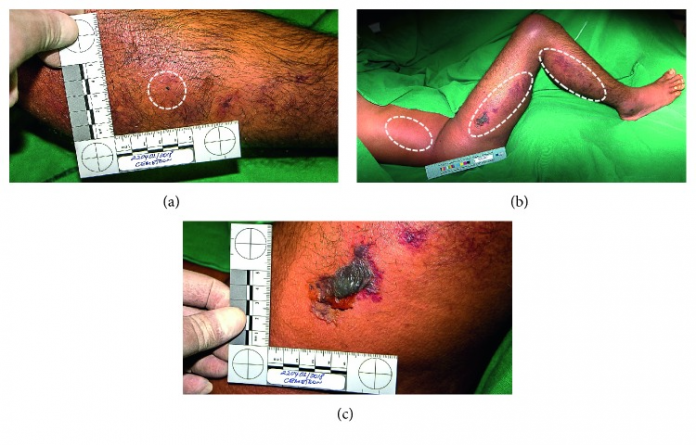
Case of compartment syndrome secondary to Bothrops snakebite, requiring decompressive fasciotimies.
This article describes the case of a 28-year-old male patient who presented to the emergency with compartment syndrome, after being bit by the snake Bothrops jararaca. He complained of pain and a punctate wound of the right leg, on the lateral aspect of the middle third. There was no other significant presentation.
On examination, the snakebite was not characteristic and there was no thorn string suspected. Doctors treated the patient for his symptoms and discharged him on analgesics. However, 5 days later, the patient returned with complaints of bullous erythema in the right lower limb, myonecrosis, bruising ecchymosis, regional lymphadenopathy, pallor, oedema and severe pain, especially around the fang marks.
Investigations findings
Physical examination was normal. This time around the patient’s white cell count was normal. Although, the patient developed leukocytosis on the second day which lasted for 8 days. In addition, his creatinine kinase levels were also high. However, during hospital admission, the patient’s creatine kinase levels began to decrease, suggestive of the patient recovering from rhabdomyolysis. Test results were also indicative of thrombocytopenia, coagulopathy and an increase in C-reactive protein with a slight alteration in levels of liver transaminase. There was no sign of acute kidney injury and creatinine levels were within normal range. Serum urea levels were elevated which indicated increased protein catabolism secondary to skeletal muscle injury.
Doctors treated the patient with antibothropic serum and antibothropic laquetic antivenin serum. His condition progressed to compartment syndrome, requiring decompressive fasciotomies. The aim of the procedure was to reduce pressure with the affected area. Doctors put the patient on analgesia with opioids and antibiotic therapy. He was sent home 71 days after the snakebite incident.
References
Compartment Syndrome following Bothrops Snakebite Leads to Decompressive Fasciotomies https://www.ncbi.nlm.nih.gov/pmc/articles/PMC6425384/



